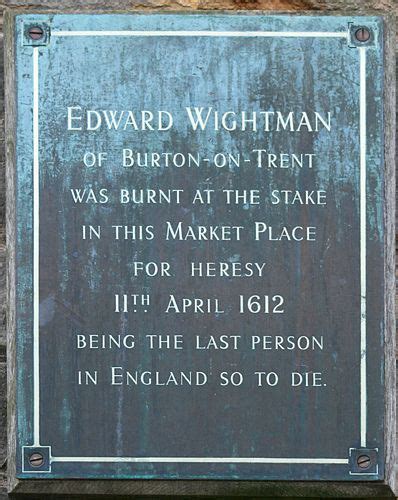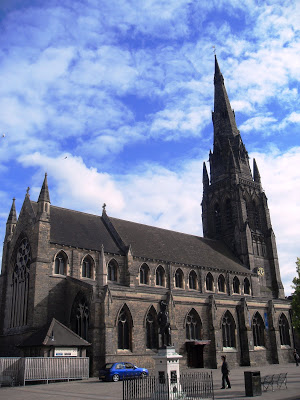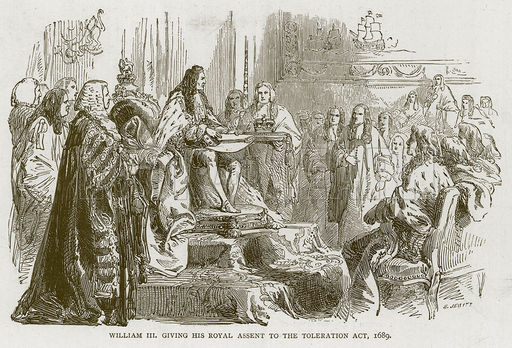
|
This is a non-WLC article. When using resources from outside authors, we only publish the content that is 100% in harmony with the Bible and WLC current biblical beliefs. So such articles can be treated as if coming directly from WLC. We have been greatly blessed by the ministry of many servants of Yahuwah. But we do not advise our members to explore other works by these authors. Such works, we have excluded from publications because they contain errors. Sadly, we have yet to find a ministry that is error-free. If you are shocked by some non-WLC published content [articles/episodes], keep in mind Proverbs 4:18. Our understanding of His truth is evolving, as more light is shed on our pathway. We cherish truth more than life, and seek it wherever it may be found. |

“If, then, dead books may be committed to flames, how much more live books, that is to say, men?”1
This is the story of Edward Wightman, a name unknown to modern Bible students, yet known to history as the last person in England to be burned at the stake for heresy.2 Like most cases of this kind, it is a story dominated by the religious and political climate of its time, an environment firmly controlled by men who held sway over all matters  pertaining to the Christian faith. Most sources are biased in their portrait of the “heretic” as some kind of demon-possessed, deranged mind. Yet Wightman was a well-respected business man and community leader, whose zeal for his faith and freedom of expression ultimately brought him to the attention of the King of England, James I. James’ religious zeal as the “Defender of the Faith” led him to sign the last known execution for burning via the stake in 1612.
pertaining to the Christian faith. Most sources are biased in their portrait of the “heretic” as some kind of demon-possessed, deranged mind. Yet Wightman was a well-respected business man and community leader, whose zeal for his faith and freedom of expression ultimately brought him to the attention of the King of England, James I. James’ religious zeal as the “Defender of the Faith” led him to sign the last known execution for burning via the stake in 1612.
Wightman’s parents hailed from Burton-upon-Trent, in Staffordshire. He was born there in 1566 and like most residents was baptized in traditional orthodox fashion. He attended Burton grammar school and entered the clothiers business of his maternal family. In 1593 he married Frances Darbye.
He became involved with the Puritans and in 1596 was chosen as one of the leaders assigned to the investigation of the demonic possession of 13-year-old Thomas Darling. This suggests that by the mid-1590s Wightman was an important and well-respected public figure, taking part in the newly formed movement that began to hold sway over Burton’s society and politics. His involvement in the Darling case proved a turning point in his life, making him entirely amenable to the possibility of unmediated spiritual intervention. Darling claimed not just to be possessed by the devil, but engaged in a series of “spiritual wars” in which both demonic and angelic voices were said to emanate from him. This was something that, as we shall see, affected the way Wightman later perceived traditional orthodoxy.
His initial descent into “heresy” involved his understanding of the mortality of the soul, a view that progressively became more radicalized and unorthodox.3 Between 1603/4 and 1610/11, his behavior grew increasingly bolder and louder. According to court records, he was a prolific writer, although his writings have not yet been found. He came to the attention of the local church authorities and a warrant for his arrest was issued. The order instructed the constables of Burton to bring him immediately before Bishop Richard Neil for interrogation.
He set about to put together a compendium of his theology for his upcoming hearing and defense. Perhaps thinking that he would at least be allowed time to plead his case, he delivered copies of it to members of the clergy in an effort to shore up support. But then, perhaps as a last resort, he delivered a copy to King James I, a move that would ultimately seal his fate.
James I came to the English throne in 1603, “thinking himself a competent judge of religious questions and disposed to take seriously his title of ‘Defender of the Faith.’”4 Since 1607 he had been engaged in a battle of books with Roman Catholic apologists over the Oath of Allegiance, both personally and by encouraging others to write in his defense. “One of the central planks of the king’s case was the preservation of his catholic orthodoxy through his adherence to the three great creeds of the church, the Apostles’, the Nicene and the Athanasian.”5
Wightman was fully aware of the king’s firm stance, yet he set about willfully to combat both his State and Church. Of the handful of fragments of his defense treatise that have survived, he refers to the doctrine “most of all hated and abhorred of Yahuwah himself...the common received faith contained in those three inventions of man, commonly called the Three Creeds...the [Apostles’], Nicene and Athanasius Creed, which faith within these 1600 years past hath prevailed in the world.”6
Wightman had by now totally isolated himself from all other groups, calling into question all aspects of Christian truth, arguing “that the baptizing of infants is an abominable custom...[and affirming that] the sacrament of baptism [is] to be administered in water to converts of sufficient age of understanding converted from infidelity to the faith.”7
But what finally spelled his end was his grievous departure from the Trinity and the nature of Yahuwah. It was presumably on these points that he so vehemently rejected the formulae of the Nicene Creed of 325 and the subsequent Creed of Constantinople of 381. He claimed that the doctrine was a fabrication and he maintained that Christ was “a mere Creature and not both Yahuwah and man in one person...[Although this did not mean that Christ was a man like all others but] only a perfect man without sin.”8 King James was by now more set than ever on securing the execution of Wightman, since in the intervening years he had launched a dual campaign against heresy at home and abroad.
After months of being subjected to a series of conferences with “learned divines,” Wightman was finally brought before Bishop Neil for the last time. According to Wightman, the Bishop told him “that unless I did recant my opinions he would burn me at a stake in Burton before all day next.” The final verdict and list of charges included “the wicked heresies of Ebion, Cerinthus, V alentinian, Arius, Macedonius, Simon Magus, Manichees, Photinus, and of the Anabaptists and other arch heretics, and moreover, of other cursed opinions belched by the instinct of Satan.”

When he was finally brought to the stake his courage had all but left him. As the fires were lit he is said to have quickly cried out to recant, although by then he had been “well scorched.” But this would not last, since two or three weeks later he was again brought before the courts and, no longer fearing the searing flames, refused and “blasphemed more audaciously than before.” The king quickly ordered his final execution, and on April 11, 1612, he was once more led to the stake.
“[Wightman] was carried again to the stake where feeling the heat of the fire again would have recanted, but for all his crying the sheriff told him he should cost him no more and commanded fagots to be set to him whence roaring, he was burned to ashes.”11
Saint Mary’s Church and the Market Square in Lichfield today (Photograph: Patrick Comerford)
In the months that followed his execution, a number of religious radicals nearly met the same fate, even though the downfall of the bishops and abolition of the High Commission in 1640-2 did not bring about any changes to the constitution. On May 2, 1648, a new “Ordinance for the Punishment of Blasphemies and Heresies” was created.12 Opposition from independents and sectaries, however, meant that the ordinance was never enforced. And only with the passage of another act in 1677 (“forbidding the burning of heretics”13) was Wightman’s position in history as the last person in England to be burned at the stake for heresy, secured. Mention of his case came almost 100 years later by a handful of writers in the wake of the 1689 Toleration Act. The only immediate result was that of a minority opposition to his execution, a shift in public opinion which may have led to a relative decline in the practice.

Meanwhile, King James I seemed to have lost faith in this method of discouraging heresy and seeing that heresy still survived, “publicly preferred that heretics hereafter, though condemned, should silently and privately waste themselves away in the prison rather than to grace them, and amuse others, with the solemnity of a public execution.”14
1 ‘Matthieu Ory, Inquisitor of Heretical Pravity for the Realm of France, Paris, 1544’. Lawrence Goldstone, Nancy Goldstone, Out of the Flames, Broadway, 2003.
2 Narrowly edging out another accused anti-Trinitarian and heretic, Bartholomew Legate, burned in London three weeks earlier.
3 In one of his early public messages he claimed that “the soul of man dies with the body and participates not either of the joys of Heaven or the pains of Hell, until the general Day of Judgment, but rested with the body until then” M. W. Greenslade, ‘The 1607 Return of Staffordshire Catholics,’ Staffordshire Catholic History, 4, 1963–4, p 6–32; Clarke, Lives of Two and Twenty English Divines, p. 147.
4 Earl Morse Wilbur, A History of Unitarianism, Harvard, 1945, p. 177.
5 F. Shriver, ‘Orthodoxy and Diplomacy: James I and the Vorstius Affair,’ ante, lxxxv, 1970, p 453-4; James VI and I, The Workes of the Most High and Mightie Prince, Iames by the Grace of Yahuwah, King of Great Britaine, London, 1616, p 302.
6 Bodleian Library, ms Ashmole, A True Relation of the Commissions and Warrants for the Condemnation and Burning of Bartholomew Legate and Thomas Withman, 1521 B, 7, 1a–1b, London, 1651, p 8.
7 Ibid., p 8-9, 23. 8 Ibid., p 5. 9 Lincolnshire Archives Office, D&C, Ciij/13/1/2/2, fo. 1r.
8 Ibid., p 5. 9 Lincolnshire Archives Office, D&C, Ciij/13/1/2/2, fo. 1r.
10 Robert Wallace, Antitrinitarian Biography, E. T. Whitfield, 1850, pp. 567-568.
11 George Birkhead, Michael C. Questier, Newsletters from the Archpresbyterate of George Birkhead, Cambridge University Press, 1998, p. 153.
12 “Principally those of the triune Yahuwah, the resurrection, the last judgment, and that the Bible is the Word of Yahuwah...relapse is to be punished as felony with death without benefit of clergy” (Felix Makower, The Constitutional History and Constitution of the Church of England, Ayer, 1972, p. 193).
13 Burning at the stake remained on the statute book in England until 1790, as the punishment for a woman who murdered her husband.
14 A. J. Loomie, Spain and the Early Stuarts 1585–1655, Aldershot, 1996, ch. 10.